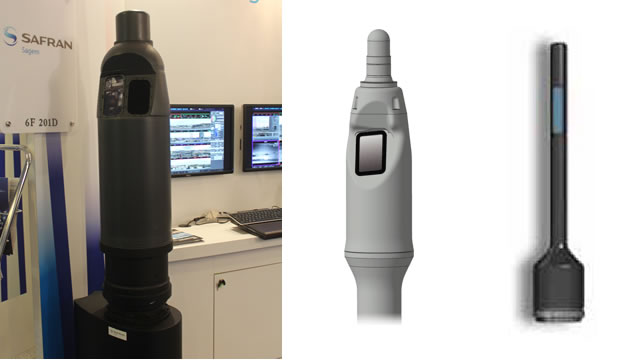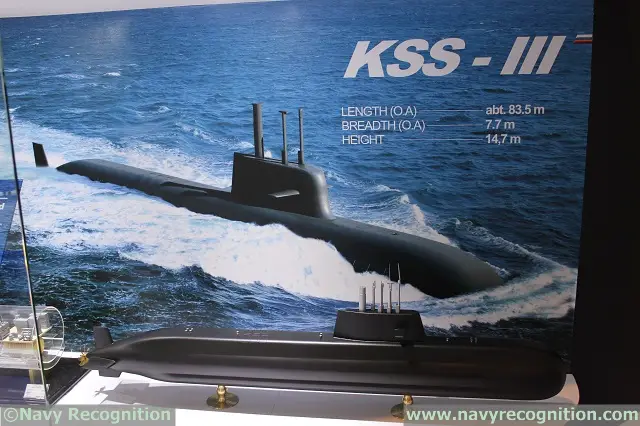Breaking news
Sagem and Thales to provide Optronic and Sonar Systems for future ROK Navy KSS-III Submarine.
| 2014
 Sagem new Series 30 optronic mast systems with modular heads: Search (left) and Attack (right) Pictures: Navy Recognition and Sagem |
|||
Sagem will likely deliver its latest periscope system:
the Series 30 Attack and Search Optronic Mast. According to Sagem, it
is the most modern and complete optronic surveillance mast on the market.
Its four simultaneously operational sensors, image processing and operating
modes make it perfect for advanced detection of airborne or surface threats.
It can equip both classic and nuclear submarines, whether new or retrofit
units.
The Series 30 SMS is a non-penetrating mast designed for above-surface surveillance: navigation safety, surveillance, intelligence collection and self-protection combining electronic and optronic warfare. Compatible with a full range of electromagnetic antenna (GPS, ESM, early warning and communication), it includes a high-definition thermal imager as well as a high-definition camera, and can simultaneously accommodate a low-light level, anti-blooming camera and a laser range finder. Its four optronic sensors, which can be used simultaneously to obtain panoramic scene captures in record time, are the fastest on the market. Known as the “Quick Look Round” feature, it enables panoramic or segment displays in separate, full resolution or compressed windows. This mode is available in addition to the conventional, live display of the different video channels. |
|||
 Thales Underwater Systems PFAS set up on a Scorpene class submarine Image: Thales |
|||
Details on the type (or types) of sonar to be provided
by the underwater division of Thales (TUS) are confidential but Navy
Recognition guess it is highly likely that KSS-III will at least
be fitted with the Planar Flank Array Sonar (PFAS) passive long range
sonar.
TUS PFAS enables full use of the large available space on the flanks of the submarine to install acoustic arrays of maximum aperture (length x height). The use of Adaptive Beamforming provides a very efficient rejection of the own ship noise and flow noise, which increases detection and classification performances even at high operational speed. Excellent bearing resolution/discrimination also enable increased Target Motion Analysis performance. A particular highlight of the TUS PFAS is its very reduced baffle which contributes to a large bearing coverage. Flank arrays feature no maneuverability constraints as compared to Clip-On Towed Arrays. |
|||
 KSS-III is a 3000 tons SSK submarine project fitted with 6x VLS (vertical launch systems) |
|||
Both the new generation optronic masts and flank array
sonars will give the new boats of the ROKN an important operational advantage
in threats detection, identification and tracking. Same technology has
already been selected by the French Navy for the future class of Barracuda
nuclear-powered submarines. KSS-III is a conventional submarine project
(SSK).
The original design of the submarine includes 6 VLS (vertical launch system) tubes. They would accomodate a future cruise missile in development by LIG Nex1 while the launchers would be provided by Doosan. It was announced earlier this year that Spanish company INDRA was selected to provide its electronic defense system (ESM) PEGASO and Babcock of the UK would design and manufacture the Weapon Handling System for the submarines. Under the Jangbogo III programme boat one is due to be handed over to the Republic of Korea Navy at the end of 2020, and boat two at the end of 2022. |
|||


























